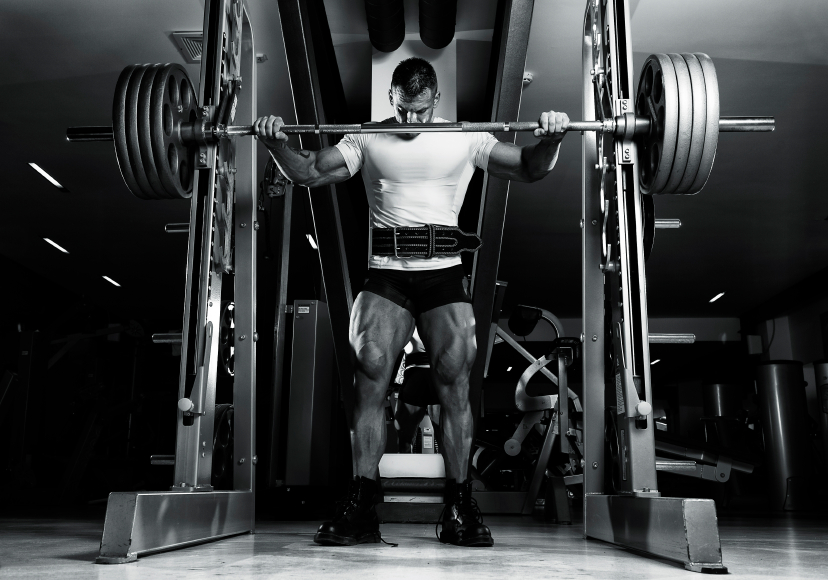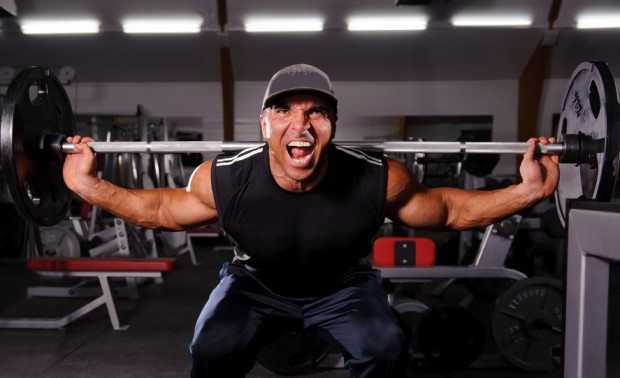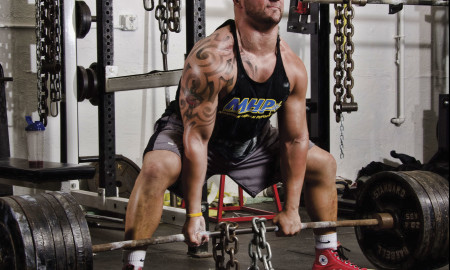


If you think a runner’s “high” is something that feels good, you should feel the endorphins release after a set of 10 heavy ball-busting squats. There’s no comparison.
Nothing will stimulate the lower body in strength, power, and devel-opment like a traditional squat. (You may hear the term Olympic squat, which is used to develop speed, athleticism, and proper range of motion for the clean and jerk; this is a different motion than a traditional squat, which will build quad, hip, and hamstring size and power.) The traditional squat has helped develop the legs of guys like Arnold and Zane, not to mention the muscular capabilities of the strongest men in the world.
Think of the squat as a standing leg press. You want to approach the rack with your body as tight as possible and your core stiff (push-ing out, not sucked in). You must be properly warmed up, mentally and physically, with a light sweat broken out, before you approach the bar. As you walk the bar back from the supports, your torso should be as tight as possible. Before starting the descent, you should be gripping the floor like a monkey and ready to bang out the sets and reps that are scheduled for this day.
1. Maintain a death grip on the bar. In fact, you should be trying to bend it with your lats as it sits on your traps. A sturdy and motion-less bar on your back is key as you prepare to squat big.
2. The walkout should consist of three steps at most. One left, one right, and then one to even up. Once you are in the stance you need, you will prepare to squat. The more you walk around with the bar, the more energy you’re wasting not building big strong legs.
3. The squat motion starts with a hip hinge. After the walkout and setting your stance, push your hips backward. Think of a kettlebell swing. Hips back, then knees bent and pushed out.
4. Don’t let your knees come way out over your toes. Some refer to this as valgus (the knee tracking too much). This will not lead to a bigger squat or legs. You don’t want this to turn into a sissy squat where the knee is over the toes.
5. Make sure the bar is locked in on your back. Some like to keep a lower bar (far down the back) and some like to keep the bar very high (closer to the neck). This really depends on many factors, including torso and leg length and the amount of muscle on one’s back. It’s a personal preference.

6. Don’t try to go way too low or cut the squat so that it’s a measly four-inch motion. (You see this in commercial gyms all the time.) A true powerlifting squat is an imagi-nary parallel line from the top of the thigh in relation to the hip joint. If you’re not a powerlifter, a good rule of thumb is to make sure your quads hit just above parallel in order achieve the most hypertrophy.
7. Always warm-up with body-weight squats and a set with just the bar before you start loading the 45-pound plates. I suggest that ev-eryone start with the bar each train-ing session and make no more than 50-pound jumps as you warm up. As you approach your heaviest sets for the day, 10 percent increments is a good rule of thumb.
8. If you are not well versed in squatting and are still new or un-comfortable, start with a kettlebell or only bodyweight squats until you can keep your back flat and have proper hip mobility and posture, and can control your body under a small load (your bodyweight).
9. Focus your sights on where the wall meets the ceiling (never look in the mirror and watch yourself). Your head should not be straight up or straight down; I refer to this as “neutral positive,” meaning straight ahead but just slightly up as if you’re looking someone in the eyes who is a bit taller than you.
10. Squat once per week, and don’t go heavy every week. Have weeks where you focus on form, speed, or working the muscles slowly. Get bet-ter each week, but don’t expect huge increases in weight. Use your assistance work to finish off your leg day. Lunges, front squats, hack squats, and leg presses are very good squat builders.
Brian Carroll is one of the most accomplished powerlifters in the history of the sport. After suffering a debilitating back injury in 2012—in-cluding several broken bones—he used the principles described in his book 10/20/Life to return to competi-tion. He has created a community of strength and fitness experts known as Power Rack Strength. Carroll most recently competed at the 2015 Arnold Classic where he won both his class and the overall title. For more info, check out powerrackstrength.com.





















You must be logged in to post a comment Login